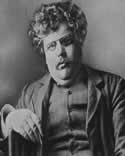Mystery Books
Mystery Movies
Mystery Authors
G. K. Chesterton biography
He is probably best known for his series about the priest-detective Father Brown who appeared in 50 stories. Between 1900 and 1936 Chesterton published some one hundred books.
G.K. Chesterton was born in London into a middle-class family. He did not learn to read until he was over eight and one of his teachers told him, "If we opened your head, we should not find brain but only a lump of white fat." Chesterton studied at University College and the Slade School of Art (1893-96). Around 1893 he had gone through a crisis of skepticism and depression and during this period Chesterton experimented with the Ouija board and grew fascinated with diabolism.- In 1895 Chesterton left University College without a degree and worked for the London publisher Redway, and T. Fisher Unwin (1896-1902). Much of his works were first published in such publications as The Speaker, Daily News, Illustrated London News, Eye Witness, New Witness, and in his own G.K.'s Weekly. Chesterton renewed his Christian faith; also the courtship of his future wife, Frances Blogg, whom he married in 1901, helped him to pull himself out of the spiritual crisis.
In 1900 appeared GREYBEARDS AT PLAY, Chesterton's first collection of poems. ROBERT BROWNING (1903) and CHARLES DICKENS (1906) were literary biographies, THE NAPOLEON OF NOTTING HILL (1904) was Chesterton's first novel, a political fantasy, in which London is seen as a city of hidden fairytale glitter, and in THE MAN WHO WAS THURSDAY (1908) Chesterton depicted fin-de-siиcle decadence. The protagonist, Syme, is a poet turned an employee of Scotland Yard, who reveals a vast conspiracy against civilization. The members of the secret anarchist gang are named for days of the week. Sunday is the most mysterious character who tells that since "the beginning of the world, all men have hunted me like a wolf - kings and sages, and poets and law-givers, all the churches, and all the philosophers. But I have never been caught yet." A stage adaptation of the story by Mrs Cecil Chesterton and Ralph Neale was produced in 1926.
In 1909 Chesterton moved with his wife to Beaconsfield, a village twenty-five miles west of London, and continued to write, lecture, and travel energetically. Between 1913 and 1914 Chesterton was regular contributor for the Daily Herald. In 1914 he suffered a physical and nervous breakdown. After World War I Chesterton became leader of the Distributist movement and later the President of the Distributist League, promoting the idea that private property should be divided into smallest possible freeholds and then distributed throughout society. In his writings Chesterton also expressed his distrust of world government and evolutionary progress, his views were often ruralist, antimodernist, Victorian. He was also very popular radio lecturer, engaging in a series of debates with George Bernard Shaw. His younger brother, Cecil, died in 1918 and Chesterton edited his brother's the New Witness and his own G.K.'s Weekly.
In 1922 Chesterton was converted from Anglicanism to Roman Catholicism, and thereafter he wrote several theologically oriented works, including lives of Francis of Assisi and Thomas Aquinas. Chesterton received honorary degrees from Edinburgh, Dublin, and Notre Dame universities. In 1934 he was made Knight Commander with Star, Order of St. Gregory the Great. - Chesterton died on June 14, 1936, at his home in Beaconsfield. His coffin, too big to be carried down the staircase, had to be lowered from the window to the ground. Dorothy Collins, Chesterton's secretary, managed his literary estate until her death in 1988.
Father Brown debuted in "The Blue Cross" in the Storyteller in 1910. To wider public the character became first known from Chesterton's book THE INNOCENCE OF FATHER BROWN (1911), a collection of twelve cases. The rest of the stories appeared in THE WISDOM OF FATHER BROWN (1914), THE INCREDULITY OF FATHER BROWN (1926), THE SECRET OF FATHER BEORN (1927), and THE SCANDAL OF FATHER BROWN (1935). In Autobiography Chesterton explained the passive character of his creation, who is virtually anonymous until the moment of the final revelation: "His commonplace exterior was meant to contrast with his unsuspected vigilance and intelligence; and that being so, of course I made his appearance shabby and shapeless, his face round and expressionless, his manners clumsy, and so on."
In his verse Chesterton was a master of ballad form, as shown in his "Lepanto", which was published in 1911. His other works include among others plays, historical studies, essays, and biographies of such authors as Robert Louis Stevenson, Leo Tolstoy, Charles Dickens, Robert Browning, Tennyson, Thackeray, George Bernard Shaw, and William Blake. Chesterton's subjects were very varied: the biography of Chaucer (1932) celebrated the Middle Ages, THE THING (1929), a collection of essays examined his own conversion to Roman Catholicism, TAKES OF THE LONG BOW (1925) propounded his social and political views.
Information source: wikipedia